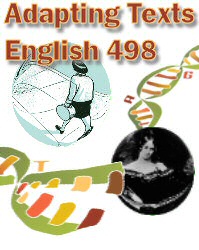 |
 |
 |
 |
|
Frankenstein Case Study AssignmentLength and Due DatesLength: 4 pages, formatted as described in the “Essays” portion
of the syllabus AssignmentFor the Frankenstein case study, you may write on one of the following topics. No matter which topic you choose, you must use adaptation theory to develop your argument. 1) Shelley Jackson titles her hypertext Patchwork Girl, or A Modern Monster. How does Jackson translate one of Frankenstein’s concerns into a modern context (for example, the relationship between creator and creation, the nature of identity, parallels between writing and creation, etc.)? 2) Patchwork Girl’s “Quilt” lexias weave strands of Frankenstein with other texts, including L. Frank Baum’s The Patchwork Girl of Oz, Barbara Maria Stafford’s Body Criticism: Imagining the Unseen in Enlightenment Art and Medicine, Jay David Bolter et al.’s Getting Started with Storyspace, Lyotard’s The Postmodern Condition, Helene Cixious’s “Coming to Writing,” and others. How does Jackson’s interweaving of text invest Frankenstein with new meanings? 3) In her article, “Frankenstein and Film,” Esther Schor notes that while cinematic adaptations of Shelley’s novel often depict speechless Creatures, they do what the novel cannot: show us the process of creation and the Creature itself. Schor argues that examining Frankenstein films for “the interplay between [the Creature’s] looming, opaque body and the revelation of his character . . . over time” can enrich our reading of the novel (66). What kind of relationship does James Whale’s 1931 version of Frankenstein set up between the Creature’s appearance and his character? What interpretation of the novel does the film’s depiction of appearance and character offer? 4) Propose your own topic that addresses Frankenstein and one or more of its adaptations. If you choose this option, you must discuss your topic with me before proceeding with your proposal. Guidelines1) Although I have asked specific questions, you will need to narrow the topics and propose an argument about the connection between adaptation and source text. For example, an essay that examines the relationship between creator and creation in Patchwork Girl could concentrate on the story of Mary Shelley’s liaison with the Patchwork Girl or on the “Broken Accents” section, a commentary on how reading creates meaning. 2) Remember to address adaptation theory in your essay, either as a component of your argument or as you support your claim. Our theoretical readings will help you shape your thesis and explore aspects of the adaptation. For example, McFarlane’s discussion of transfer may help you analyze elements of the Creature’s character highlighted in Whale’s film. Casetti’s arguments regarding the intertextual frame may aid your treatment of Patchwork Girl's “quilt” of words from multiple texts. 3) You are writing to an audience who has already read the novel, viewed the film, or navigated the hypertext. Therefore, your essay should not summarize the texts’ contents. Instead, any references—quotations, image descriptions, explanations of plot movement or visual patterns—should support your analysis. 4) As you develop your argument, don’t forget the discussion of Frankenstein on the posting board and the feedback you received on your proposal. A review of the postings and your peers’ commentary on your ideas will help you to ask key questions and shape your analysis. 5) If you’re having difficulty devising an approach to the essay, or if you want to discuss ideas-in-progress, email me or come to my office hours in Padelford A-305. ProposalThe proposal assignment allows you to develop a tentative thesis, pose arguments related to this thesis, identify potential evidence and consider organizational strategies for your case study In completing the proposal, you will produce a roadmap to guide your writing process. The proposal should include the following components:
GradingGrades for the case study will be calculated on a 40-point scale. Essays are due at the time indicated; work submitted after the due date and time will be considered late. Late essays will receive a 10-point deduction per day late, including weekends and holidays. I will make exceptions to the lateness policy only in cases of documented illness or family emergency.
Last Update: 5/4/06
|